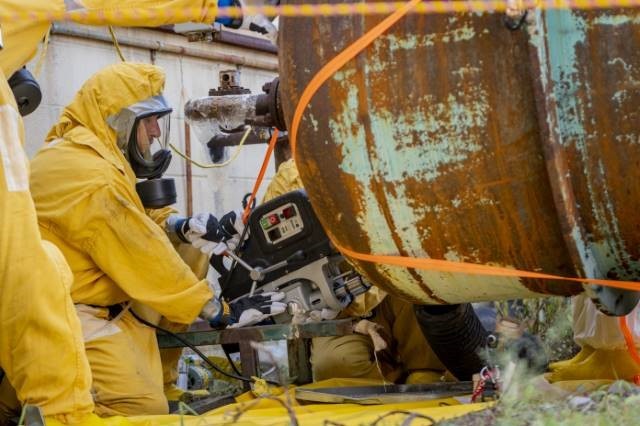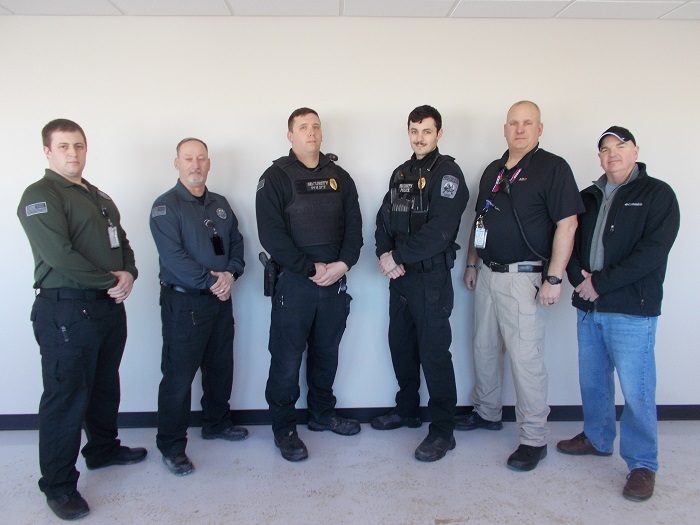 More than 100 students make up the first joint cohort of Savannah River Site production operator apprentices at Aiken Technical College this year.
AIKEN, S.C. – Three Savannah River Site (SRS) contractors recently collaborated to welcome their first joint cohort of apprentices as part of the Nuclear Fundamentals Program, which will provide over 100 trained operators to the site upon its completion.
The Operator Apprentice Program started as a partnership with SRS managing and operating contractor Savannah River Nuclear Solutions (SRNS), Aiken Technical College, Apprenticeship Carolina and the Lower Savannah Council of Governments. The program is part of the site’s broader Apprenticeship School.
The eight-month program enables students to complete their classroom work and on-the-job training simultaneously. They spend two days a week in the classroom and two days a week at the site. At the end of the program, participants will have earned a certificate in nuclear fundamentals.
For the latest round of operator apprentices, SRNS joined with SRS liquid waste contractor Savannah River Mission Completion and Savannah River National Laboratory to offer over 100 openings for the program. The EM laboratory is managed and operated by contractor Battelle Savannah River Alliance.
Apprentices will learn the basic qualifications of a production operator, including conduct-of-operations principles, radiation worker training and qualification, and conducting shift rounds. Those who successfully complete the program are hired and put to work in areas across SRS.
“This is the sixth cohort of operator apprentices SRNS has hired and the largest group to date,” said Dorian Newton, SRNS program manager for Apprenticeship School and Pipeline Training. “We are excited to see this program grow and to partner with other site contractors. This program is beneficial not only to our companies, but to SRS as a whole and to the community.”
SRMC also welcomed its largest class of operators in its history with 53 new hires set out to fill key roles in various SRS liquid waste facilities.
“Operators are on the front lines of safely and successfully running the site’s nuclear facilities,” said Dave Olson, SRMC president and program manager. “Effective and proper training is essential to ensuring our operators possess the critical skills for their jobs. We are thankful for this joint effort with SRNS, Aiken Technical College, and Apprenticeship Carolina to provide the quality training for future SRS operators. These employees have bright futures ahead should they choose to grow in their careers at SRS.”
-Contributor: Lindsey MonBarren
 Paducah Site workers load cylinders into a waste container during C-333-A Feed Vaporization Facility deactivation activities.
PADUCAH, Ky. – Workers have removed materials such as oils, combustibles and environmental hazards from the C-333-A Feed Vaporization Facility at EM’s Paducah Site as part of recent actions to prepare the building and its adjoining process gas building for future demolition.
The estimated 8,300-square-foot facility provided feed material to the uranium enrichment process when the site operated as a gaseous diffusion plant. This small facility was connected to the C-333 Process Building and used steam autoclaves to convert feed material to a gas that could be used to enrich uranium. At about 1.1 million-square feet, the C-333 Process Building was one of four large process buildings used at the Paducah Site to enrich uranium.
“While the feed facility is relatively small compared to the adjoining process building, removing materials from C-333-A and disconnecting it from the process building provides a critical step towards the deactivation of the C-333 Process Building,” EM Portsmouth/Paducah Project Office Manager Joel Bradburne said.
 Mechanics use a magnetic drill to cut a sample from cylinders used in the feed process at the C-333-A Feed Vaporization Facility.
In addition to reducing hazards in the building, recent deactivation of C-333-A included the safe and compliant removal and disposition of all process gas equipment from the facility. Paducah Site deactivation and remediation contractor Four Rivers Nuclear Partnership (FRNP) led efforts to remove approximately 2,806 feet of process gas equipment piping, 4,630 feet of instrument tubing and 313 process gas components, including valves, instrumentation and other items.
“With C-333-A now disconnected from the process building, we are focused on the deactivation of the C-333 Process Building,” FRNP Program Manager Myrna Redfield said. “Our team has taken every precaution to ensure our activities not only reduce hazards at the site, but continue to be protective of our workforce, the public and the environment.”
-Contributors: Dylan Nichols, Jessica Vasseur
 Richard Carson and Jonathan Zimmer are now EM West Valley Demonstration Project (WVDP) security police officers after completing training at DOE’s National Training Center. From left are WVDP Protective Force Lt. James Madsen, WVDP Protective Force Capt. James Madden, Carson, Zimmer, CH2M HILL BWXT West Valley Safeguards and Security Manager Dave Schuman and WVDP Security Manager Mark Simsick.
“We understand the importance and benefit of having trained emergency responders working at West Valley,” EM WVDP Security Manager Mark Simsick said. “As trained and qualified officers, they now have increased responsibilities to protect the health and safety of our workers and the public. We recognize and appreciate their continued commitment to serve others.”
The two officers, Richard Carson and Jonathan Zimmer, had previously worked as unarmed security officers at the site.
The course included firearm qualifications, defensive tactics, use of force, first aid and combat casualty care, vehicle stops, DOE tactical doctrine, physical fitness and other required courses of study.
Dave Schuman, safeguards and security manager for EM cleanup contractor CH2M HILL BWXT West Valley, said it was important for the WVDP team to recognize the graduates for completing the training.
“This training pushed these recruits both mentally and physically, and we applaud them for their commitment and perseverance,” Schuman said. “They spent time away from their families so they could better serve and protect the site, its employees and the community.”
Quality training programs are essential to support the protection of critical Departmental assets, national security, and the environment, as well as the health and safety of the workforce and the public, according to the National Training Center.
-Contributor: Joseph Pillittere
 Concrete blocks are loaded onto a metal base and transporter during tests on a gantry crane system that will lift replacement melters for the Waste Treatment and Immobilization Plant at the Hanford Site.
RICHLAND, Wash. – EM Office of River Protection tank operations contractor Washington River Protection Solutions (WRPS) and subcontractor Atkins are making progress in their preparations to provide replacement melters for the Direct-Feed Low-Activity Waste (DFLAW) Program to treat tank waste at the Hanford Site.
Earlier this month crews successfully tested a crane capable of lifting the 300-ton melters that will be assembled offsite. The gantry crane is a stationary steel structure with hydraulic “legs” that move the load up and down.
“Crews assembled the first two melters inside the Waste Treatment and Immobilization Plant (WTP), which is where we will vitrify, or immobilize in glass, radiological and chemical tank waste,” said Joe Renevitz, EM waste treatment operations engineer. “The melters are expected to last about five years, so we want to have replacement melters ready to install in order to minimize downtime.”
 Crews measure the distance between a transporter and mock-up melter base during the successful crane test.
The gantry crane test started with lifting a mock-up melter base weighted with concrete blocks, simulating the size and weight of a fully assembled melter. The crane lifted the materials a few inches off a trailer, leveled it out and lowered the simulated melter onto rails. Workers repeated the maneuvers several times to ensure a safe and successful transfer. Motion sensors collected data that engineers used to determine what acceleration forces the load had experienced. Acceleration forces are important for making sure the crane movements are slow enough for the heavy load.
“Assembled melters have never been transported and lifted as is planned on the Hanford Site,” said William Young, WRPS engineer. “The weight of the melters when fully assembled is about 80% of the capacity of the gantry crane.”
The sensors will remain in place during practice runs to simulate transporting the melter more than 21 miles to the WTP. Engineers will use the sensor data to ensure that heating components inside the melter won’t shift during transport.
“We’re asking a lot of questions throughout the melter assembly process, to identify potential challenges before encountering them,” said Young. “Testing various scenarios is an important part of making sure the system is ready.”
-Contributor: Jenna Kochenauer
|